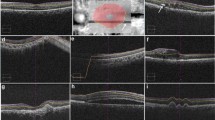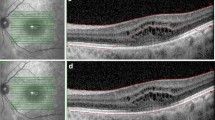Abstract
Purpose
Automated spectral domain optical coherence tomography (SD-OCT) segmentation algorithms currently do not perform well in segmenting individual intraretinal layers in eyes with Stargardt disease (STGD). We compared selective B-scan segmentation strategies for generating mean retinal layer thickness and preserved area data from SD-OCT scans in patients with STGD1.
Methods
Forty-five eyes from 40 Stargardt patients were randomly selected from the ongoing Natural History of the Progression of Atrophy Secondary to Stargardt Disease (ProgStar) study. All eyes underwent SD-OCT using a standard macular volume consisting of 1024 × 49 equally spaced B-scans within a 20 × 20 degree field centered on the fovea. All 49 B-scans were segmented manually to quantify total retina, outer nuclear layer (ONL), photoreceptor inner segments, photoreceptor outer segments (OS), and retinal pigment epithelial layer (RPE). Mean thickness and total area were generated using all 49 B-scans (spaced 122 μm apart), 25 B-scans (every other B-scan, spaced 240 μm apart), 17 B-scans (every third scan, 353 μm apart), and 13 B-scans (every fourth scan, 462 μm apart), as well as by using an “adaptive” method where a subset (minimum 25 B-scans) of B-scans that the grader deemed as significantly different from adjacent B-scans were utilized. Mean absolute and percentage errors were calculated for macular thickness and area of different retinal layers for the different B-scan subset selection strategies relative to using all 49 B-scans, which was considered the reference or ground truth.
Results
Mean thickness and area measurements were significantly different for any regularly spaced reduction in B-scan density relative to the ground truth. When an adaptive approach was applied using a minimum of half the scans, the differences relative to ground truth were no longer significantly different. The mean percent differences for the area and thicknesses of the various layers ranged from 0.02 to 33.66 (p < 0.05 for all comparisons) and 0.44 to 7.24 (p > 0.05) respectively.
Conclusion
Manual segmentation of a subset of B-scans using an adaptive strategy can yield thickness and area measurements of retinal sublayers comparable to the reference ground truth derived from using all B-scans in the volume. These results may have implications for increasing the efficiency of SD-OCT grading strategies in clinical trials for STGD and other related macular degenerative disorders.


Similar content being viewed by others
References
Sadda SR, Wu Z, Walsh AC et al (2005) Errors in retinal thickness measurements obtained by optical coherence. Tomography:285–293. https://doi.org/10.1016/j.ophtha.2005.10.005
Sadda SR, Keane PA, Ouyang Y et al (2010) Impact of scanning density on measurements from spectral domain optical coherence tomography. Invest Ophthalmol Vis Sci 51:1071–1078. https://doi.org/10.1167/iovs.09-4325
Strauss RW, Ho A, Muñoz B et al (2016) The natural history of the progression of atrophy secondary to Stargardt disease ( ProgStar ) studies design and baseline characteristics : ProgStar report no. 1. Ophthalmology:1–12. https://doi.org/10.1016/j.ophtha.2015.12.009
Ritter M, Zotter S, Schmidt WM et al (2016) Characterization of Stargardt disease using polarization- sensitive optical coherence tomography and fundus autofluorescence imaging. https://doi.org/10.1167/iovs.12-11550
Strauss RW, Muñoz B, Wolfson Y et al (2015) Assessment of estimated retinal atrophy progression in Stargardt macular dystrophy using spectral- domain optical coherence tomography:1–7. https://doi.org/10.1136/bjophthalmol-2015-307035
Park JC, Collison FT, Fishman GA et al (2015) Objective analysis of hyperreflective outer retinal bands imaged by optical coherence tomography in patients with stargardt disease. Investig Ophthalmol Vis Sci 56:4662–4667. https://doi.org/10.1167/iovs.15-16955
Nittala MG, Konduru R, Ruiz-Garcia H, Sadda SR (2011) Effect of OCT volume scan density on thickness measurements in diabetic macular edema. Eye (London, England) 25:1347–1355. https://doi.org/10.1038/eye.2011.173
Velaga S, Nittala M, Parinitha B et al (2016) Correlation between retinal sensitivity and cystoid space characteristics in diabetic macular edema. Indian J Ophthalmol 64:452. https://doi.org/10.4103/0301-4738.187675
Velaga SB, Nittala MG, Konduru RK, et al (2016) Impact of optical coherence tomography scanning density on quantitative analyses in neovascular age-related macular degeneration. Eye (London). doi: https://doi.org/10.1038/eye.2016.260
Keane PA, Liakopoulos S, Jivrajka R V, et al (2016) Evaluation of optical coherence tomography retinal thickness parameters for use in clinical trials for Neovascular age-related macular degeneration AND. 3378–3385. https://doi.org/10.1167/iovs.08-2728
Author information
Authors and Affiliations
Corresponding author
Ethics declarations
Data collection and analyses were approved by the Institutional Review Board of the University of California Los Angeles
Conflict of interest
Dr. Sadda receives research support from Carl Zeiss Meditec, Optos, and serves as a consultant to Optos, Heidelberg, and Centervue. Other authors have no financial disclosures.
Ethical approval
All procedures performed in studies involving human participants were in accordance with the ethical standards of the institutional and/or national research committee and with the 1964 Helsinki declaration and its later amendments or comparable ethical standards. Informed consent was obtained from all individual participants included in the study.
Rights and permissions
About this article
Cite this article
Velaga, S.B., Nittala, M.G., Jenkins, D. et al. Impact of segmentation density on spectral domain optical coherence tomography assessment in Stargardt disease. Graefes Arch Clin Exp Ophthalmol 257, 549–556 (2019). https://doi.org/10.1007/s00417-018-04229-3
Received:
Revised:
Accepted:
Published:
Issue Date:
DOI: https://doi.org/10.1007/s00417-018-04229-3




